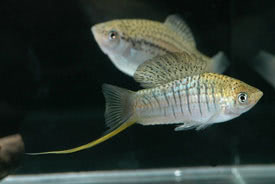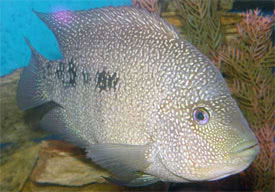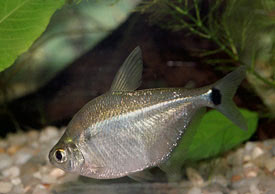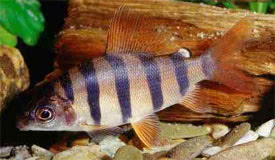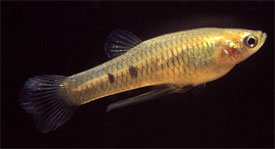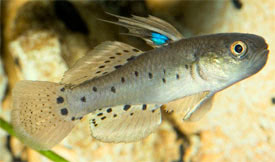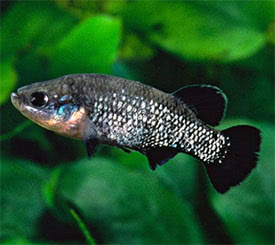
 Magyarul / Hungarian
Magyarul / Hungarian
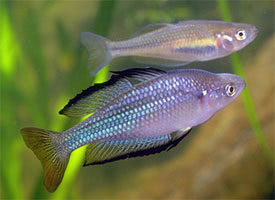
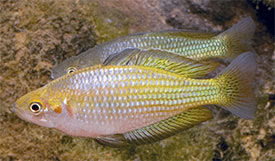
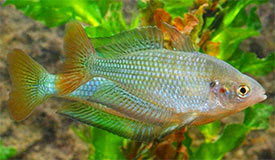
- Scientific name: Melanotaenia fluviatilis
- Synonyms: Aristeus fluviatilis, Melanotaenia splendida fluviatilis
- Common name: Australian Rainbowfish
- Group: Rainbowfish
- Habitat: South-East Australia
- Size: male: 10-11 cm, female: 7 cm
- Biotope: Found in slow-moving parts of rivers and still waters such as ponds and lakes with dense aquatic vegetation.
- Social behavior: A very peaceful and active shoaling fish, but can disturb smaller fish with its fast movements and relatively large size. They can be skittish and does far better when kept in a small group of 6-8 species.
- Diet: Omnivorous; They accept most foods including pellet and flake as well as live or frozen foods. Feed them with live foods regularly to ensure the fish exhibit their best colors.
- Breeding: Quite easy
- Tank: Minimum 110 litres
- Population: 6-8 fishes for 200 litres
- Decoration: Provide areas of dense vegetation, along with some open areas for swimming. Choose aquatic plants that prefer slightly hard, alkaline conditions. Use dark substrate. Water movement should be kept to a minimum.
- Temperature: 20-25 °C
- pH: 6.5-8
- Hardness: 8-20 NK°
- Lifespan: 5-8 years
Description: Melanotaenia fluviatilis has an elongated and laterally compressed body, which olive-green or brownish on the back and grading to white on the lower half. Australian rainbowfish has two dorsal fins and slightly forked caudal fin. There is a thin reddish stripe between each horizontal scale row in mature males. Fins are clear to reddish, sometimes with faint spotting. Males may have blackish margins on the dorsal, anal, and anterior margin of the pelvic fins, especially during spawning. Australian Rainbowfish is not a common fish in the hobby. Melanotaenia fluviatilis is the most southerly ranging rainbowfish in Australia and is the only species adapted to low winter temperatures. In cold water the fish will be considerably less active and will lose color, and there is also evidence that the fish begin to die off below 10 °C. Australian Rainbowfish is suitable for outdoor pond culture in temperate climates. Melanotaenia fluviatilis is very similar to Melanotaenia duboulayi and until 1986 these two species was considered the same. Principal variations are in body depth, fin ray counts, and color pattern. In addition, there are clear differences in egg characteristics and larval development. There are also some differences between the southern and northern populations of the fish, as southern populations often have a broader head and blunter snout.
The males will also be encouraged to display their best colors in the company of conspecifics. Mature males are larger and have brighter coloration than females, and females have smaller, rounded dorsal and anal fins. In the nature spawning usually occurring from October to January as water temperatures rise. In captivity spawning will occur throughout the year if temperature is maintained above 20°C. The breeding of the Australian Rainbowfish is not too hard, but the raising of the fry can be tricky. The breeding aquarium should be at least 80 cm long and contain slightly hard, alkaline water (pH 7.5) and a temperature of 23-24°C. The tank should be filled with fine-leaved plants such as java moss. A small air-powered filter is enough in the tank, and the substrate isn’t necessary. Before spawning condition the males and females in a separated tank with live and frozen foods. Before spawning the male's colour intensifies, becoming emerald green, the throat orange and the tailfin red. At this point select the best colored male and female, and put them into the spawning tank, and rise the water temperature a little. The pair will spawn for a period of several weeks, laying batches of eggs each day. The eggs are attached to plants by fine threads. The number of the eggs are between 100 and 150. After spawning the eggs should be removed, as the parents may eat them. The eggs hatch after 5-9 day, which depends on the temperature: 9 to 14 days at 20°C; 7 days at 24-25°C; 6 days at 26-27°C; 4-5 days above 28°C. The newly hatched fry are 2.5 to 4.2 mm in length and should be fed with infusoria or liquid fry food until they are large enough to eat small live foods such as brine shrimp nauplii. Sinking pellet foods are not good, as the fry usually stay very close to the water surface. At 32 days after hatching, the length of the larval is about 13-15 mm and at 72 days 21-25 mm.





